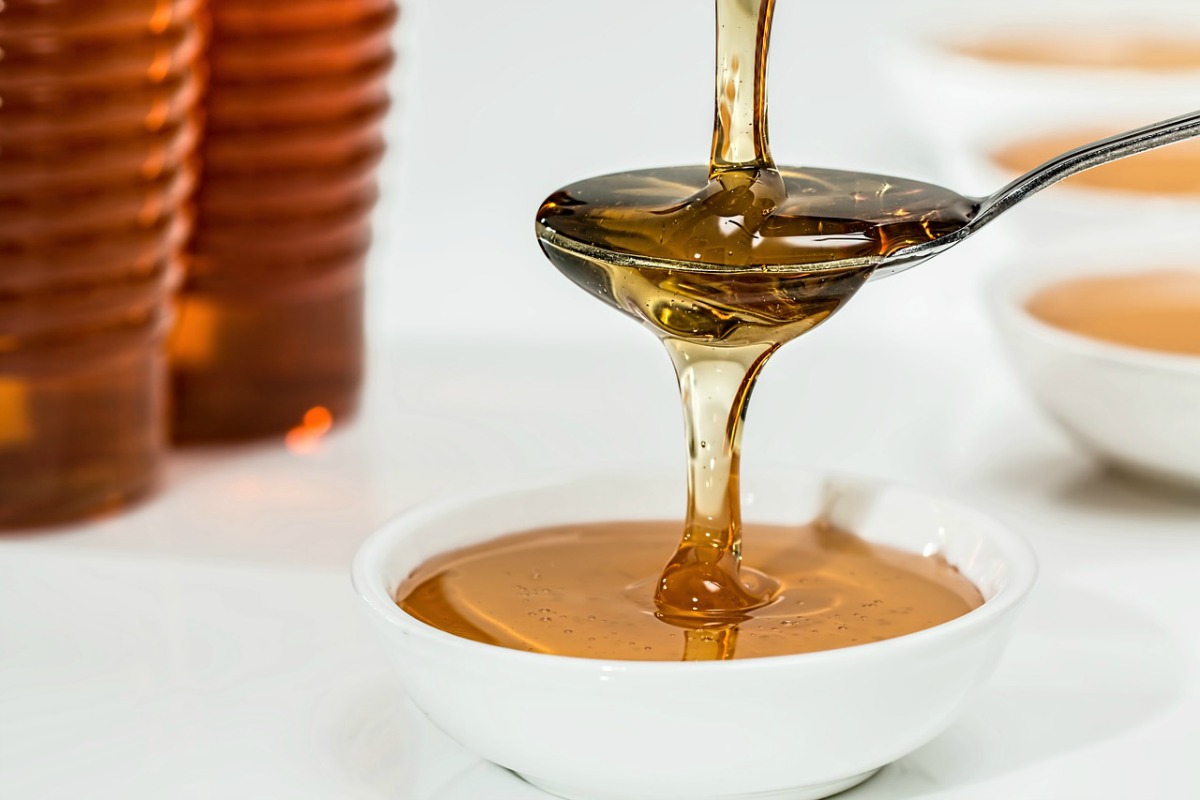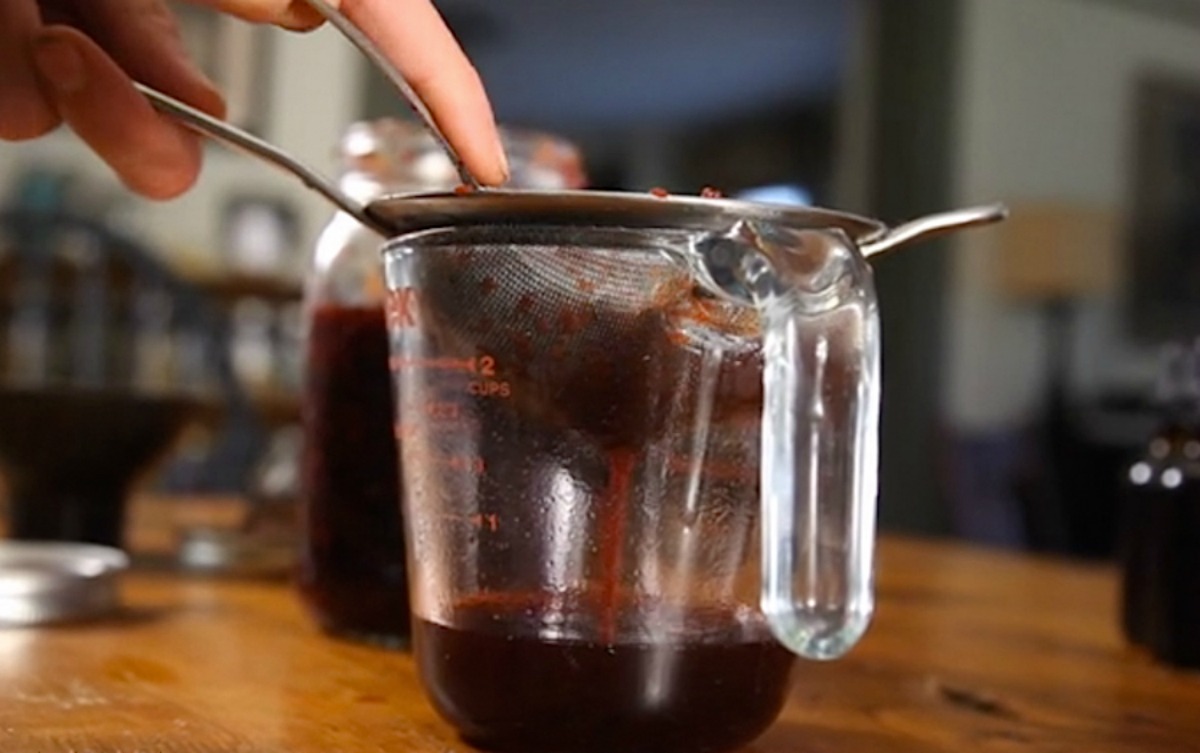
How to Make an Herbal Syrup
The cold days of autumn and winter bring to mind cozy socks, warm cups of tea, good books, and for many herbalists, pots of simmering herbal syrup. Perhaps one of the most delicious ways to take herbs, herbal syrups are wonderful to have on hand during the colder months of the year. Enjoy learning the basics of how to make an herbal syrup and then let your intuition guide you to create your own tasty blends!
What is an Herbal Syrup?
An herbal syrup is prepared by combining a concentrated decoction with either honey or sugar, and sometimes alcohol. The base of such a syrup is a strong herbal decoction. Mixing a decoction with honey or sugar helps to thicken and preserve the decoction. This increases the shelf life of the decoction and often creates a soothing application that benefits situations such as sore throat, cough, dry irritated tissues, and digestive issues. The added sweetener can also help to increase the palatability of some herbs. Many folks, including children, find syrups to be delicious!
Herbal syrups make a yummy addition to beverages and food! Combine a spoonful or two of syrup with carbonated water to create a tasty and healthful herbal soda. You can also make a quick cup of tea by adding a spoonful of syrup to hot water. Enjoy your syrup by drizzling it on foods like yogurt, oatmeal, biscuits, and ice cream or just enjoy by the spoonful.

How to Make an Herbal Syrup
Creating your own herbal syrup at home is surprisingly easy! If you have children around invite them to make the syrup with you. Just like with cooking, children who get involved with making herbal preparations are more likely to try them when the time comes.
The basic proportions you want to use are 2 parts herbal decoction to 1 part honey or sugar. This is called a 2:1 ratio. This means that if you start with your herbs added to 4 cups of water and simmer down the liquid to 2 cups of decoction, then you will want to add 1 cup of honey or sugar to create and adequately preserve your syrup.
Some herbalists like to use a 1:1 ratio of decoction to honey/sugar while others find a 1:1 ratio to result in a syrup that is too sweet. The increased amount of honey/sugar relative to decoction in a 1:1 ratio will be better preserved and hence last longer. Experiment and see which ratio works best for you!
You can further enhance and preserve your herbal syrup with the optional addition of alcohol. Herbal tinctures selected for their beneficial properties can be included in syrup formulas as well. Brandy is another popular addition to syrups. The alcohol helps to further preserve the syrup and can also aid in calming the recipient (Gladstar, 1993). The addition of alcohol is completely optional and may not be the best choice when making syrups for children.

Use this recipe to make your own herbal syrup choosing the herbs that suit you best!
½ cup to 1 cup of dried herbsBasic Herbal Syrup Recipe
1 quart of cool water
1 to 2 cups of honey or sugar
Brandy or tinctures, optional
Great Herbs For Syrups
Any herbs can be used to make delicious herbal syrup though some lend themselves especially well to this form of herbal preparation. Some examples of herbs commonly used in syrups include elderberry (Sambucus nigra or S. canadensis), ginger (Zingiber officinale), astragalus (Astragalus mongholicus), hawthorn (Crataegus spp.), rose (Rosa spp.) hips, licorice (Glycyrrhiza glabra), schisandra (Schisandra chinensis), echinacea (Echinacea spp.), as well as tasty, sweet spices like cinnamon (Cinnamomum spp.), cloves (Syzygium aromaticum), and cardamom (Elettaria cardamomum). Other herbs that aren’t so tasty such as dandelion (Taraxacum officinale), horehound (Marrubium vulgare), elecampane, and vervain, are often extracted into syrup form to increase palatability.
Feel free to experiment with herb choices when making this wonderful form of herbal preparation. Why not use some lovely nervines and adaptogens such as lemon balm, St. John’s wort, holy basil, and ashwagandha to help support your nervous system? Or try a combination of herbs used to soothe digestive issues such as fennel, ginger, cinnamon, dandelion root, or marshmallow. Great herbs to use in syrups for respiratory issues include thyme, elecampane, and licorice.
When learning how to make an herbal syrup or any other herbal preparation, be sure to consult your favorite herbal books for assistance in herb choices or visit our extensive online Herbarium, where you will find detailed monographs on numerous herbs!
Four Favorite Herbs to Use in Syrups
Let’s look a little bit deeper at four herbs that are often brewed into herbal syrup!
1. Elderberry – Sambucus nigra, S. Canadensis
The beloved berry star for herbal syrup, elderberries can be used to make a delicious syrup that is perfect for the winter months when the flu virus and other virus abound.
Elder is referred to time and again as “the medicine chest for the country people,” alluding to its wide-ranging medicinal actions and ready availability. Elderflower and elderberry are both exceptional allies during colds, flu, and respiratory infections due to their diaphoretic and antiviral actions. Taken at onset, elderberry can reduce the duration of cold/flu because it interferes with virus replication, and strengthens cell walls to inhibit viral penetration (Hoffmann, 2003). Elderberry has been the subject of numerous research studies. In one placebo-controlled, double-blind study using Sambucol (a syrup containing elderberry juice), significant improvements in flu symptoms were seen in 93.3% of the elderberry treated group within 2 days.
– Elder Monograph from The Herbarium, para. 3, 6, and 7
Enjoy this recipe for Quick and Simply Elderberry Cold Syrup.
2. Astragalus – Astragalus membranaceous
The root of this wonderful plant is used as a preventative as well as to help folks who are through the acute phase of illness and in need of some support for recovery (Winston & Maimes, 2007).
The polysaccharides in astragalus support and stimulate the immune system via several mechanisms. Research indicates astragalus increases the production of white blood cells, antibodies and interferon, which signals white blood cells to multiply or fight infection (Foster & Johnson, 2006). Herbalists Guido Masé and Deb Soule recommend taking astragalus regularly in the fall and winter to strengthen immunity and keep colds, flu, and bronchitis at bay (Masé, 2013). [As an adaptogen] astragalus nourishes and supports the adrenal glands, which produce hormones that regulate the body’s response to stress. As a nourishing tonic, astragalus is immune building as well as immune restorative. – Astragalus Monograph from The Herbarium, para. 4 and 5
3. Ginger – Zingiber officinale
Many of the common culinary spices we all have available in our kitchen cupboards have useful herbal properties and ginger is no exception! Delightfully warming with anti-inflammatory and antispasmodic properties, ginger is used by herbalists to help with digestive, muscular, and menstrual-associated pain (“Ginger,” n.d.). It also is used as an effective antiviral.
Ginger’s antiviral actions include stimulating macrophage activity, preventing viruses from attaching to cell walls, and acting as a virucide. It also possesses actions that encourage it as a catalyst and synergist in antimicrobial herbal formulas, helping to increase their action by dilating blood vessels and enhancing circulation. – Ginger Monograph from The Herbarium, para. 4
Find a recipe to make your own delicious Ginger Syrup here.
4. Elecampane – Inula helenium
The roots of this warming, expectorant herb have long been used to support the respiratory system. Information from the elecampane monograph in The Herbarium shows us that:
Elecampane is warming and clearing to the lower respiratory system, effectively expelling congestion and stuck energy. In addition to being an excellent expectorant, it also soothes the tissue irritation and inflammation that results from coughing. Elecampane’s ability to move congestion is also helpful in the digestive system. The bitter principle associated with its volatile oils stimulates digestion and appetite (Hoffmann, 2003), helping to clear damp congestion and resolve poor digestion. – Elecampane Monograph from The Herbarium, para. 6 and 8

Recipes for Tasty Herbal Syrup
Now that you know how to make an herbal syrup are you ready to give it a try? Below are a couple of recipes to get you started. Check out this double rose syrup recipe made with rose hips and petals for a delightful and super simple recipe. Enjoy one of the recipes below, or create your own blend! Whip up a batch of this wonderful herbal syrup the next time a sore throat or a cough comes to visit.
8 tablespoons total to 1-quart water
Throat & Cough Soothing Syrup
2 tablespoons elecampane for a cough or 2 tablespoons echinacea for a sore throat. Both can be used to help with a cough and sore throat!
2 tablespoons licorice (Glycyrrhiza glabra) root
2 tablespoons elderberries (Sambucus nigra or S. canadensis)
1 tablespoon ginger (Zingiber officinale) rhizome
1 tablespoon cinnamon (Cinnamomum spp.) chips or 2 cinnamon sticks
The peel from one organic orange
1-quart cool water
1 to 2 cups honey
¼ cup brandy or rose petal tincture, optional
This tasty little blend helps to gently create a strong foundation especially during times of stress or when one has been overwhelmed for a long time.
3 tablespoons ashwagandha rootStrong & Calm Syrup
3 tablespoons eleuthero root
3 tablespoons hawthorn (Crataegus spp.) berries
1-quart cool water
1 to 2 cups of honey or sugar
Have fun crafting your own delicious herbal syrup blends and bring this wonderful herbal preparation into your home during the darker months of the year. You won’t be disappointed!
Learn more about various herbal preparations and how to make them in our beautiful medicine-making flipbook, available in unit 1 of our Intermediate courses.

REFERENCES
Astragalus Monograph. (n.d.). Retrieved on 9/14/2016 from http://herbarium.herbalacademyofne.com/monographs/#ID=1025
Elder Monograph. (n.d.). Retrieved on 9/08/2016 from http://herbarium.herbalacademyofne.com/monographs/#ID=1005
Elecampane Monograph. (n.d.). Retrieved on 9/14/2016 from http://herbarium.herbalacademyofne.com/monographs/#ID=3039
Ginger Monograph. (n.d.). Retrieved on 9/14/2016 from http://herbarium.herbalacademyofne.com/monographs/#ID=1012
Gladstar, Rosemary. (1993). Herbal healing for women. New York, NY: Fireside.
Green, James. (2000). The herbal medicine-maker’s handbook. Berkeley, CA: Crossing Press.
Groves, Maria. (2016). Body into balance, an herbal guide to holistic self-care. North Adams, MA: Storey Publishing.
Winston, David, and Maimes, Steven. (2007). Adaptogens. Herbs for strength, stamina, and stress relief. Rochester, VT: Healing Arts Press.









